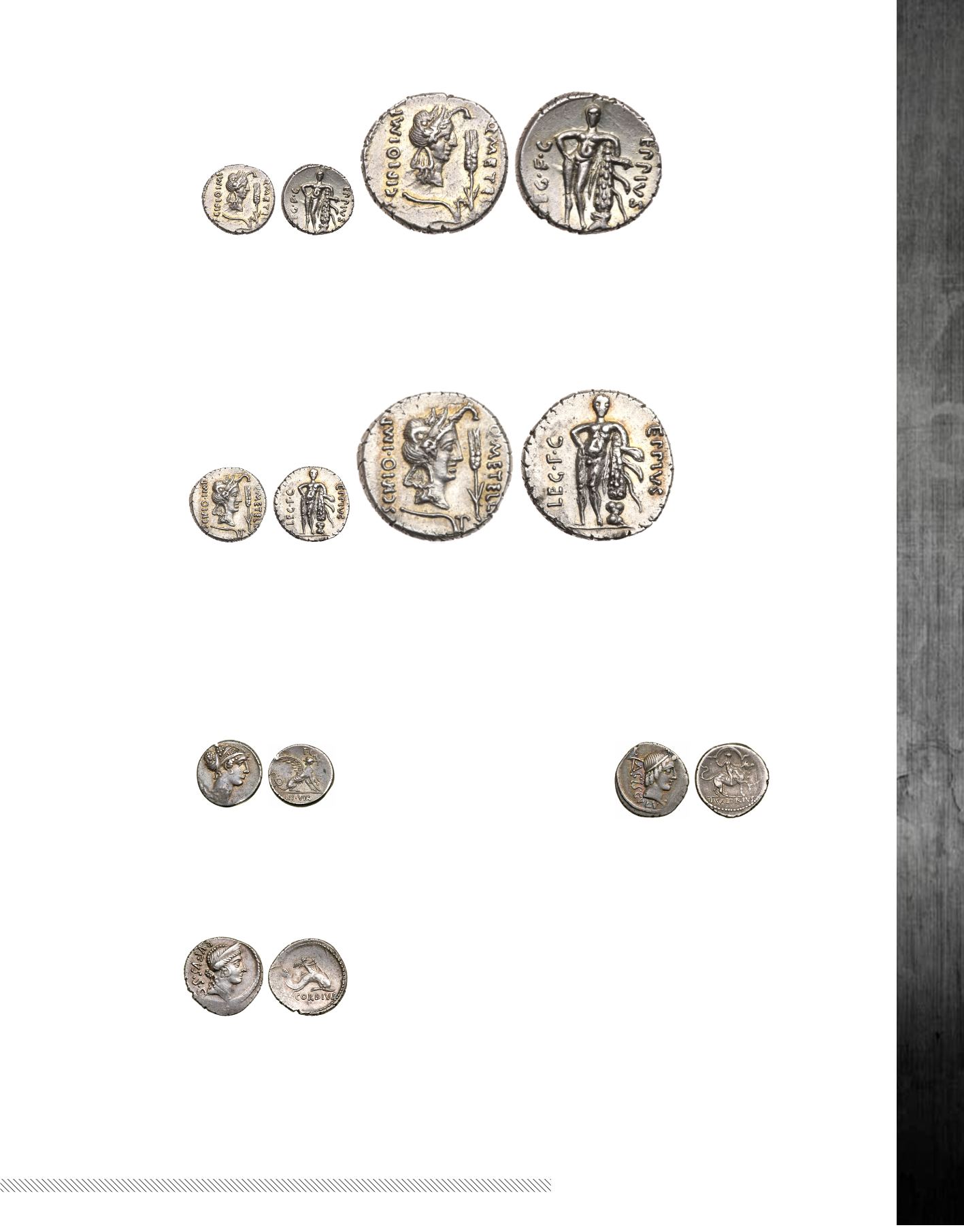

160
bid online at
www.goldbergcoins.com(800) 978-COIN (2646)
|
Ancient Coins
Enlargement
1988 Q. Caecilius Metellus Pius Scipio and Eppius. Silver Denarius (3.83 g), 47-46 BC
. Military mint traveling with Scipio in Africa. Q METEL[L]
SCIPIO IMP, head of Africa right, wearing elephant' skin headdress; in right field, grain stalk; below, plow.
Reverse:
EPPIVS LEG F C, Hercules
standing facing, resting hand on hip and leaning on club draped with lion' s skin and set on rock. Crawford 461/1; HCRI 44; Sydenham 1051; Cae-
cilia 50. Delicately toned.
Nearly Mint State
.
Estimate Value .......................................................................................................................................................................$1,000 - 1,500
From The Herbert & Aphrodite Rubin Collection; Purchased from an uncertain NFA auction in the 1970s-1980s, lot 287.
Enlargement
1989 Q. Caecilius Metellus Pius Scipio and Eppius. Silver Denarius (3.80 g), 47-46 BC
. Military mint traveling with Scipio in Africa. Q METELL
SCIPIO IMP, head of Africa right, wearing elephant' skin headdress; in right field, grain stalk; below, plow.
Reverse:
EPPIVS LEG F C, Hercules
standing facing, resting hand on hip and leaning on club draped with lion' s skin and set on rock. Crawford 461/1; HCRI 44; Sydenham 1051; Cae-
cilia 50. Perfectly centered and well struck. Lightly toned.
Superb Extremely Fine
.
Estimate Value .......................................................................................................................................................................$1,000 - 1,500
From The Herbert & Aphrodite Rubin Collection; Ex CNG XXII (2 September 1992), 304 (illus. on back cover).
The obverse type depicting Africa wearing an elephant headdress is remarkable in that it ultimately derives from Ptolemaic Egyptian representa-
tions of Alexander the Great as conqueror of Asia used on coins struck at Alexandria. Under the Roman Empire it was transmitted back to Alexan-
dria where a female figure wearing the elephant headdress became the standard personification of the city.
1990
T. Carisius. Silver Denarius (3.69 g), 46 BC
. Rome. Head
of Sibyl Herophile right, hair bound.
Reverse:
T CAR[IS]IVS
above and to right, III VIR in exergue, Sphinx seated right.
Crawford 464/1; CRI 69; Sydenham 983b; Carisia 11a. Toned.
Choice Very Fine
.
Estimate Value ..................................................... $250 - 300
1991
Mn. Cordius Rufus. Silver Denarius (3.92 g), 46 BC
.
Rome. RVFVS S C, diademed head of Venus right.
Reverse:
MN
CORDIVS below, Cupid riding dolphin right. Crawford 463/3;
HCRI 65; Sydenham 977; Cordia 3. Nicely toned. An area of
weakness.
Very Fine
.
Estimate Value ..................................................... $150 - 200
1992
L. Valerius Acisculus. Silver Denarius (3.65 g), 45 BC
.
Rome. ACISCVLVS behind, diademed head of Apollo Soranus
right surmounted by star; behind, pick-axe.
Reverse:
L
VALERIVS in exergue, Europa seated on bull walking right, hold-
ing veil which billows out above her. Crawford 474/1a; HCRI 90;
Sydenham 998; Valeria 17. Toned.
Very Fine
.
Estimate Value ......................................................$250 - 300
It has traditionally been believed that the reverse shows the
heroine Valeria Luperca riding a heifer. However, the animal is
clearly a bull, which means that the seated female can only be
Europa. The myth of Europa is that she was a Phoenician prin-
cess whose beauty attracted the attention of the god Zeus.
Desiring her, he turned himself into a magnificent white bull and
intermingled with her father' s herd. When she saw him, she
approached him and stroked his side, then leaped onto his
back. Zeus immediately ran out to sea and swam to Crete,
where Europa became the island' s first queen. Subsequently,
Zeus arranged the stars known as the constellation Taurus in
the shape of the white bull which he had assumed during this
episode.



















